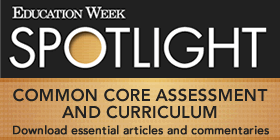Flexing billions of dollars of purchasing muscle, more than 30 of the nation’s largest districts have come together to say they will only buy common-core instructional materials that meet a set of “publishers’ criteria” written by a nonprofit organization that played a leading role in crafting the new standards.
The new criteria, meant to govern the development of instructional materials aligned with the English/language arts portion of the standards, were publicized June 28 at a press event organized by the Council of the Great City Schools, the Washington-based membership group to which the districts belong. But the criteria were released last summer by the New York City-based Student Achievement Partners, whose founders were among the lead writers of the Common Core State Standards now adopted by all but four states.
Winston Brooks, the superintendent of the 95,000-student Albuquerque school district in New Mexico and a member of the council’s executive committee, said in an interview that “we need to make sure we demand that publishers respect the work that we’ve done on the common core.” The pact among the school districts “will make it a little easier to hold publishers’ feet to the fire,” he said.
He added: “I can’t open my email these days without seeing certain publishers saying they’ve aligned everything to the common core. We’re putting [publishers] on notice, and we’re going to be watching.”
The agreement includes districts serving New York City; Los Angeles; Chicago; Clark County, Nev.; and Hillsborough County, Fla., all among the nation’s largest.
Michael Casserly, the executive director of the council, said he expects more districts to sign on. The council noted that its 67 member districts serve 8 million students and spend $2 billion to $4 billion each year on instructional resources, including textbooks and online materials. The districts have also agreed to adhere to publishers’ criteria for mathematics materials based on the common core, which are expected to be released later this year.
‘Road Map’ for Change
The agreement on language and literacy materials provides a partial road map for publishers who are now wrestling over how to craft useful texts for districts as they shift to the common standards.
The common core itself represents a major educational shift and new demands on teachers. They will be expected to teach students how to “read widely and deeply from among a broad range of high-quality, increasingly challenging literary and informational texts,” according to the standards, and to learn how to use different techniques to produce nuanced and complex writing. The standards themselves, however, don’t go into detail on how student textbooks and instructional materials should look, thus the creation of the publishers’ criteria.
To fully reflect the standards, for example, the publishers’ criteria for grades 3-12 note that “80 to 90 percent of the reading standards in each grade require text-dependent analysis; accordingly, aligned curriculum materials should have a similar percentage of text-dependent questions.”
An example of part of the publishers’ criteria for grades K-2 notes that “though there is a productive role for good general questions for teachers and students to have at hand, materials should not over-rely on ‘cookie cutter’ questions that could be asked of a text, such as, ‘What is the main idea? Provide three supporting details.’ ” Rather, the criteria say, questions should be individually crafted and draw students into the texts at hand.

Publishers have supported the criteria as a necessary first step in helping them put together textbooks and other instructional materials, said Jay A. Diskey, the executive director of the school division of the American Association of Publishers, in Washington. His organization represents major educational publishers such as Houghton Mifflin Harcourt, McGraw-Hill, Pearson Education, and Scholastic.
However, it’s a long way from setting criteria to developing, adopting, and publishing curricular materials and programs, he added. For example, many states and districts convene committees of teachers that evaluate whether materials are aligned to standards. Those committees follow guides that are more detailed than the publishers’ criteria in their current form. The question publishers have, he said, is how the criteria will figure into actual procurement decisions.
Charlene Gaynor, the chief executive officer of the Association of Educational Publishers, in Wilmington, Del., concurred. The shift to the common-core standards “represents, in some ways, a total upheaval in how materials have been developed,” she said. “It really shifts more toward comprehension and asking the right type of questions, as opposed to ‘read this text and answer these questions.’ ”





